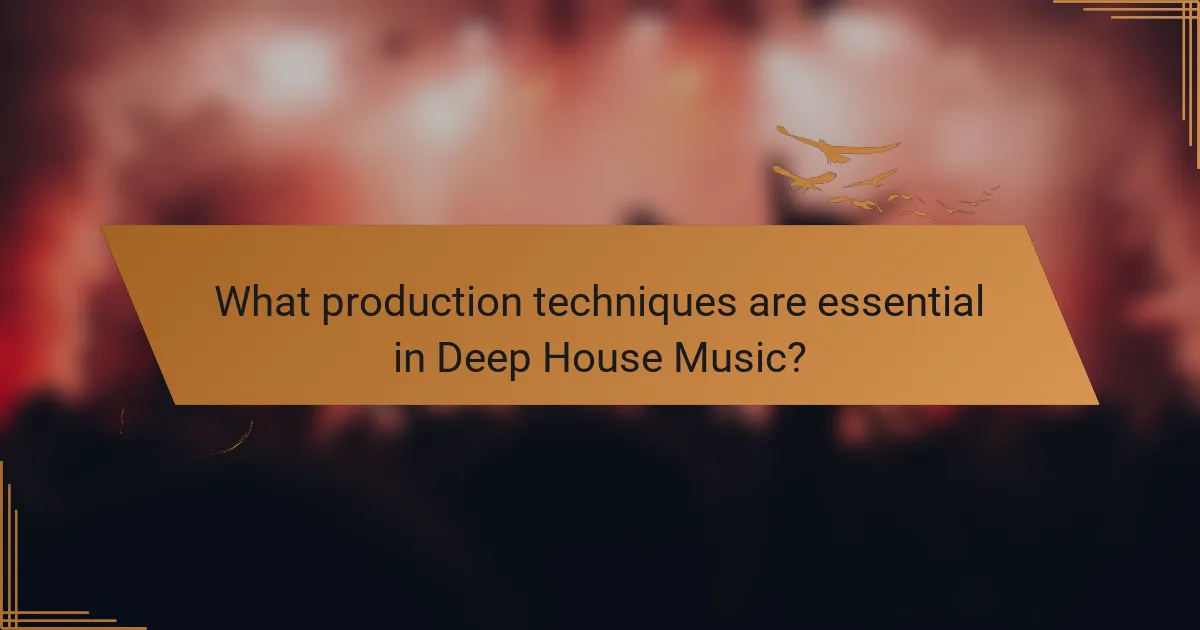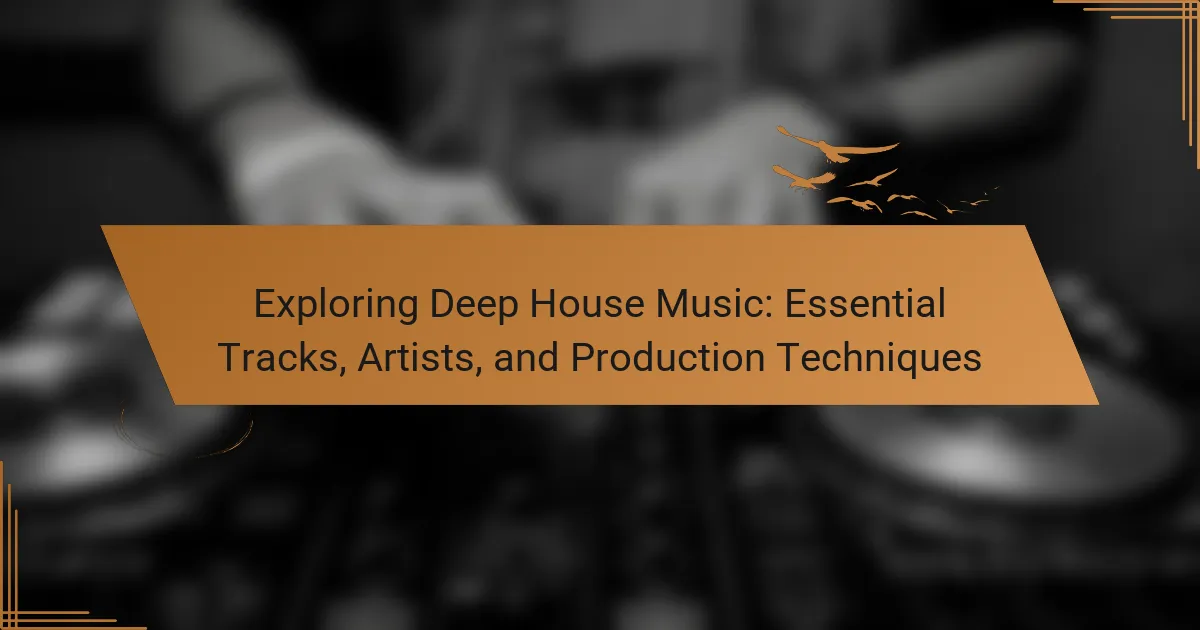Deep House Music is a subgenre of house music that emerged in the 1980s, characterized by its fusion of jazz, soul, and funk elements with electronic sounds. This genre features smooth, melodic lines, a slower tempo of 120 to 125 beats per minute, and often includes complex chords and lush instrumentation. Key artists such as Larry Heard, Kerri Chandler, and modern contributors like Disclosure and Maya Jane Coles have significantly shaped its evolution. Essential tracks like “Can’t Get Enough” by Soulsearcher and “Deep End” by John Summit highlight the genre’s distinct sound and production techniques, which incorporate warm synths, deep basslines, and intricate rhythms. The article explores the foundational aspects of Deep House Music, including its history, notable artists, essential tracks, and production methods that define its rich musical landscape.

What is Deep House Music?
Deep House Music is a subgenre of house music that originated in the 1980s. It combines elements of jazz, soul, and funk with electronic music. The sound is characterized by smooth, melodic lines and a slower tempo, typically ranging from 120 to 125 beats per minute. Deep house often features complex chords and lush instrumentation. Vocals in deep house tracks are usually soulful and subdued. The genre gained popularity in the 1990s, particularly in clubs and underground scenes. Notable artists include Larry Heard and Kerri Chandler. Deep house remains influential in modern electronic music, with numerous contemporary artists incorporating its elements.
How did Deep House Music originate?
Deep House Music originated in the 1980s as a subgenre of house music. It emerged in Chicago, influenced by soulful and jazz music elements. Pioneering artists like Larry Heard contributed to its distinctive sound. The genre features smooth melodies, deep basslines, and atmospheric elements. Deep House gained popularity in clubs and underground scenes. Its evolution incorporated influences from disco and funk. By the 1990s, it spread to Europe, particularly in the UK and Germany. Today, Deep House continues to evolve, maintaining its roots while embracing new styles.
What cultural influences shaped the development of Deep House?
Deep House music was shaped by various cultural influences. Its roots can be traced back to the Chicago house music scene of the 1980s. This genre incorporated elements from disco, soul, and jazz. The use of lush, melodic chords is a hallmark of Deep House. African American culture played a significant role in its development. The genre often reflects themes of love and community. Additionally, the Detroit techno scene influenced its rhythmic structures. European influences, particularly from the UK, helped to further evolve the sound. This blend of cultural elements created the unique identity of Deep House music.
Who were the pioneering artists in the Deep House genre?
Pioneering artists in the Deep House genre include Larry Heard, Frankie Knuckles, and Kerri Chandler. Larry Heard, also known as Mr. Fingers, released influential tracks like “Can You Feel It” in 1986. Frankie Knuckles, often called the “Godfather of House,” was instrumental in shaping the genre during the 1980s. Kerri Chandler is known for his deep, soulful sound and tracks like “Bar A Thym.” These artists laid the groundwork for Deep House music, blending elements of jazz, soul, and funk. Their contributions continue to influence contemporary Deep House artists today.
What are the defining characteristics of Deep House Music?
Deep House Music is characterized by its smooth, soulful sound and complex melodies. It typically features a tempo range of 120 to 125 BPM. The genre often incorporates jazzy or funky elements, which add depth to the music. Deep house is known for its use of lush, atmospheric synths and deep basslines. Vocals in deep house are often soft and emotive, enhancing the overall vibe. The genre frequently employs samples from disco, jazz, and soul music. It emerged in the 1980s, evolving from Chicago house music. Notable artists include Larry Heard and Kerri Chandler, who significantly influenced its development.
How does the tempo and rhythm distinguish Deep House from other genres?
Deep House is distinguished by its unique tempo and rhythm. Typically, Deep House tracks range from 120 to 125 beats per minute. This tempo creates a relaxed yet danceable vibe. The rhythm often features syncopated basslines and smooth, flowing grooves. These elements contribute to a laid-back atmosphere compared to genres like Tech House or Trance. Additionally, Deep House often incorporates soulful vocal samples and melodic elements. This combination of tempo and rhythm fosters an immersive listening experience. Overall, the specific tempo and rhythmic patterns set Deep House apart from other electronic music genres.
What instrumentation is commonly used in Deep House tracks?
Deep House tracks commonly use synthesizers, drum machines, and basslines. Synthesizers create lush chords and melodic elements. Drum machines provide the characteristic four-on-the-floor beat. Basslines are often deep and groovy, enhancing the track’s rhythm. Additionally, vocal samples and pads contribute to the atmospheric quality. Instruments like electric pianos and guitars may also be included for texture. These elements combine to create the signature sound of Deep House music.

What are the essential tracks in Deep House Music?
“Essential tracks in Deep House Music include ‘Can’t Get Enough’ by Soulsearcher and ‘Deep End’ by John Summit. These tracks exemplify the genre’s signature sound. ‘Can’t Get Enough’ features soulful vocals and a groovy bassline. It was released in 1998 and became a classic in the deep house scene. ‘Deep End’ showcases modern production techniques and has gained popularity since its release in 2019. Other notable tracks are ‘So Good to Me’ by Chris Malinchak and ‘I Feel for You’ by Bob Sinclar. Each of these tracks contributes to the deep house genre’s rich musical landscape.”
Which tracks are considered classics in the Deep House genre?
Tracks considered classics in the Deep House genre include “Can You Feel It” by Mr. Fingers, “Your Love” by Frankie Knuckles, and “Deep Inside” by Hardrive. These tracks are pivotal in defining the sound and essence of Deep House. “Can You Feel It,” released in 1986, is often credited as a foundational track due to its emotive melodies and deep basslines. “Your Love,” a collaboration between Frankie Knuckles and Jamie Principle, is celebrated for its innovative use of synthesizers and vocal samples. “Deep Inside,” released in 1993, is recognized for its iconic vocal hooks and driving rhythm. These tracks have significantly influenced the genre’s development and continue to be celebrated in modern Deep House sets.
What makes these tracks iconic within the Deep House community?
These tracks are iconic within the Deep House community due to their unique sound and emotional depth. They often feature rich basslines and soulful melodies. The use of vocal samples adds a human touch that resonates with listeners. Many iconic tracks have influenced the genre’s evolution and shaped its cultural landscape. Artists like Frankie Knuckles and Larry Heard are pivotal figures whose works remain timeless. Their tracks often incorporate elements of jazz and funk, enhancing the overall listening experience. The production techniques used, such as layering and reverb, create an immersive atmosphere. Collectively, these factors contribute to the tracks’ status as classics in the Deep House genre.
How have these tracks influenced modern Deep House music?
These tracks have significantly influenced modern Deep House music by shaping its sound and production techniques. Classic Deep House tracks introduced lush, melodic elements and deep basslines that are now foundational. They established a slower tempo that characterizes the genre, typically ranging from 120 to 125 BPM. The use of soulful vocals and jazzy chords became prevalent, creating an emotive atmosphere.
Additionally, the incorporation of sampling techniques and intricate layering has become a standard in contemporary productions. Tracks from the 1990s laid the groundwork for the resurgence of Deep House in the 2010s, influencing artists like Disclosure and Duke Dumont. The emphasis on groove and rhythm in these classic tracks has been mirrored in modern productions, ensuring the genre’s evolution while maintaining its core essence.
What are some contemporary Deep House tracks worth exploring?
Some contemporary Deep House tracks worth exploring include “Turn Me On” by Riton and Kah-Lo. This track features catchy vocals and a rhythmic beat. Another notable track is “Cola” by CamelPhat and Elderbrook. It gained significant popularity and topped charts globally. “Losing It” by Fisher is also a standout track, known for its infectious energy. “Deep End” by John Summit showcases a groovy bassline and uplifting vibes. These tracks exemplify the modern Deep House sound and have received positive acclaim in the electronic music scene.
Which artists are currently leading the Deep House scene?
Artists currently leading the Deep House scene include Black Coffee, Peggy Gou, and Solomun. Black Coffee is known for his unique blend of Afro-house and deep sounds. Peggy Gou has gained popularity for her energetic sets and distinct style. Solomun is recognized for his influential role in the European club scene. These artists consistently top charts and are featured in major festivals. Their music is characterized by deep basslines and melodic elements. They also have a significant social media presence, connecting with fans globally.
How do these contemporary tracks reflect the evolution of Deep House?
Contemporary tracks reflect the evolution of Deep House through their innovative use of sound and production techniques. These tracks often incorporate elements from various genres, blending traditional Deep House with influences from techno, ambient, and even pop music. The shift towards more melodic and atmospheric sounds is evident in recent releases.
Artists now frequently utilize advanced digital production tools, enhancing the depth and texture of their music. This evolution is marked by the incorporation of live instruments and vocals, creating a richer listening experience. Tracks often feature complex rhythms and layered synths, which were less common in earlier Deep House music.
Furthermore, the rise of streaming platforms has allowed for greater accessibility and diversity in the genre. This has led to a broader audience and the emergence of new sub-genres within Deep House. The integration of global musical influences has also played a significant role in the genre’s evolution.
Overall, contemporary Deep House tracks showcase a dynamic progression while maintaining the genre’s core characteristics.

Who are the key artists in Deep House Music?
Key artists in Deep House Music include Larry Heard, known for his pioneering work in the genre. Another significant figure is Kerri Chandler, recognized for his soulful sound. Artists like Maya Jane Coles have also gained prominence with innovative productions. Deep House duo Disclosure has contributed to the genre’s mainstream appeal. Additionally, artists such as Âme and Solomun are influential in the scene. These artists have shaped Deep House with their unique styles and productions. Their contributions have defined the sound and direction of the genre.
What are the most influential Deep House artists?
The most influential Deep House artists include Larry Heard, Frankie Knuckles, and Kerri Chandler. Larry Heard, known as Mr. Fingers, pioneered the genre in the 1980s with tracks like “Can You Feel It.” Frankie Knuckles, often referred to as the “Godfather of House,” significantly shaped Deep House with his remixes and productions. Kerri Chandler is recognized for his unique sound and contributions to the genre’s development. These artists have left a lasting impact on Deep House music through their innovative styles and timeless tracks. Their work continues to inspire new generations of producers and DJs.
How have these artists contributed to the genre’s development?
These artists have significantly shaped the development of deep house music. They introduced innovative production techniques that blended elements of jazz, soul, and funk. Artists like Larry Heard and Frankie Knuckles pioneered the genre in the 1980s. Their use of smooth basslines and atmospheric synths set the foundation for deep house. Additionally, they emphasized emotional depth in their tracks, influencing subsequent artists. The rise of vocal samples in their music created a more immersive listening experience. This evolution attracted a broader audience to the genre. Their contributions established deep house as a staple in electronic music culture.
What unique styles do these artists bring to Deep House Music?
Artists in Deep House Music introduce unique styles through varied influences and techniques. For instance, some artists incorporate jazz elements, creating a sophisticated sound. Others blend Afrobeat rhythms, adding a vibrant and energetic feel. Vocalists may contribute soulful melodies, enhancing emotional depth. Experimental producers often use unconventional samples, pushing creative boundaries. Additionally, some artists emphasize minimalism, focusing on stripped-down beats and textures. Each artist’s individual background shapes their distinctive approach. This diversity enriches the Deep House genre, appealing to a wide audience.
Which emerging artists should be on the radar for Deep House fans?
Emerging artists to watch for Deep House fans include Anjunadeep’s latest signings, such as Marsh and Ben Böhmer. Marsh has gained attention for his melodic soundscapes and emotive tracks. Ben Böhmer is known for his atmospheric productions and live performances. Additionally, artists like Nora En Pure and Luttrell are creating waves in the scene. Nora En Pure blends deep house with organic elements. Luttrell’s tracks often feature lush melodies and intricate beats. These artists are consistently featured in playlists and festivals, indicating their rising popularity in the Deep House genre.
What fresh perspectives are these new artists bringing to the genre?
New artists are introducing innovative sounds and diverse influences to the deep house genre. They blend elements from various genres such as techno, ambient, and even world music. This fusion creates unique auditory experiences that challenge traditional deep house norms. Additionally, many of these artists emphasize emotional storytelling through their tracks. They often incorporate personal narratives and cultural references into their music. This approach resonates with a broader audience, making deep house more accessible. Furthermore, the use of modern production techniques enhances the overall sound quality. Many new artists leverage technology to create intricate soundscapes. These fresh perspectives are revitalizing the genre and expanding its reach.

What production techniques are essential in Deep House Music?
Deep House music production techniques include the use of warm synths, deep basslines, and smooth vocal samples. These elements create the signature sound of the genre. Layering is crucial for building depth and richness in tracks. Sidechain compression is often employed to achieve a pumping effect, enhancing the groove. Reverb and delay are utilized to create space and atmosphere. Additionally, sample selection plays a vital role in defining the overall vibe. Using drum machines and MIDI programming helps in crafting intricate rhythms. Finally, automation is essential for adding movement and dynamics throughout the track.
How is Deep House Music typically produced?
Deep House Music is typically produced using digital audio workstations (DAWs) and various electronic instruments. Producers often start by creating a solid drum pattern. This usually includes deep bass kicks, snares, and hi-hats. Next, they layer synths and pads to establish a rich harmonic structure.
Melodic elements are often incorporated, featuring smooth, jazzy chords. Vocal samples may be added to enhance the emotional depth of the track. Effects such as reverb and delay are commonly used for atmosphere.
The final mix is crucial, ensuring all elements blend well together. Mastering is the last step, preparing the track for distribution. This production approach emphasizes groove and soulful melodies, characteristic of Deep House.
What software and tools are commonly used in Deep House production?
Common software and tools used in Deep House production include digital audio workstations (DAWs) like Ableton Live, FL Studio, and Logic Pro. These platforms provide essential features for music creation and editing. Synthesizers such as Serum and Massive are popular for crafting deep basslines and melodic elements. Additionally, plugins like Omnisphere and Kontakt offer a wide range of sounds suitable for the genre. Drum machines, including the Roland TR-808, are frequently used for creating rhythmic patterns. Effects processors such as reverb and delay are crucial for adding depth to tracks. These tools collectively enable producers to create the signature sound of Deep House music.
What are the key mixing techniques that define Deep House tracks?
Key mixing techniques that define Deep House tracks include smooth transitions, layered sounds, and reverb effects. Smooth transitions create a seamless flow between tracks. This is often achieved through beat matching and careful tempo adjustments. Layered sounds enhance the depth and richness of the mix. Deep House often incorporates melodic elements, vocal samples, and basslines that complement each other. Reverb effects are used to create space and atmosphere. This technique helps to blend sounds and adds a sense of depth. EQ adjustments are crucial for balancing frequencies. This ensures that each element occupies its own sonic space. Finally, sidechain compression is frequently utilized. This technique allows the kick drum to punch through the mix, creating a dynamic feel.
What role does sound design play in Deep House Music production?
Sound design is crucial in Deep House Music production. It shapes the overall aesthetic and mood of the track. Unique sounds create an immersive listening experience. Producers often use synthesizers to develop rich textures. Layering different sounds enhances depth and complexity. Effects like reverb and delay add spatial qualities. Sound design also influences the groove and rhythm. Ultimately, it contributes to the genre’s signature vibe and emotional resonance.
How do producers create the signature sounds of Deep House?
Producers create the signature sounds of Deep House by utilizing specific production techniques and sound elements. They often incorporate smooth, soulful vocals layered over rich, melodic chords. Basslines in Deep House are typically deep and rolling, providing a groove that drives the track. Producers also use atmospheric pads and synths to create a lush soundscape. Additionally, they employ drum patterns that feature a four-on-the-floor kick, complemented by hi-hats and claps. Effects like reverb and delay are frequently applied to enhance space and depth in the mix. The use of samples from jazz, funk, and soul music is common, adding a unique character to the sound. These elements combine to form the distinctive vibe associated with Deep House music.
What are some common effects used in Deep House production?
Common effects used in Deep House production include reverb, delay, and compression. Reverb adds depth and space to sounds, creating a more immersive listening experience. Delay creates echo effects, enhancing rhythmic elements in tracks. Compression balances dynamic range, ensuring all elements are heard clearly. Equalization (EQ) shapes frequencies, allowing specific sounds to stand out. Filtering is often used to create build-ups and drops by gradually removing frequencies. Distortion can add warmth and character to sounds, making them more engaging. Lastly, modulation effects like chorus and flanger enrich the sound texture, providing a lush quality. These effects are essential in defining the Deep House sound.
What tips can help aspiring Deep House producers improve their craft?
Aspiring Deep House producers can improve their craft by focusing on several key areas. First, they should study the genre’s foundational tracks to understand its sound. Analyzing works by influential artists like Larry Heard and Kerri Chandler can provide insight into deep basslines and atmospheric elements.
Second, mastering music production software is essential. Programs like Ableton Live and FL Studio are popular among producers for their versatility. Learning how to use these tools effectively can enhance creativity and production quality.
Third, developing a unique sound is crucial. Producers should experiment with different samples, synths, and effects. Creating a signature style can help them stand out in a crowded market.
Fourth, networking with other musicians and attending workshops can provide valuable feedback and collaboration opportunities. Engaging with the community can lead to new ideas and partnerships.
Lastly, continuous practice and experimentation are vital. Regularly producing tracks and seeking constructive criticism can lead to significant improvement over time.
Deep House Music is a subgenre of house music that emerged in the 1980s, characterized by its smooth melodies, deep basslines, and atmospheric elements. The article explores the origins of Deep House, its cultural influences, and key pioneering artists such as Larry Heard and Kerri Chandler. It details the defining characteristics, essential tracks, and contemporary artists shaping the genre today, while also discussing production techniques and sound design that create its signature sound. Additionally, the article highlights emerging artists and offers tips for aspiring producers looking to enhance their craft in Deep House music.
